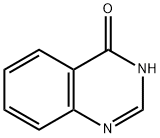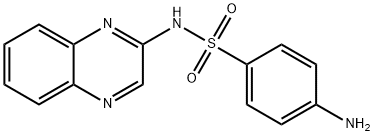4-Hydroxyquinazoline , ≥98.0%(HPLC) , 491-36-1
Synonym(s):
4-Quinazolinol
CAS NO.:491-36-1
Empirical Formula: C8H6N2O
Molecular Weight: 146.15
MDL number: MFCD00511302
EINECS: 207-735-8
| Pack Size | Price | Stock | Quantity |
| 5G | RMB32.80 | In Stock |
|
| 25G | RMB55.20 | In Stock |
|
| 100g | RMB191.20 | In Stock |
|
| 500g | RMB799.20 | In Stock |
|
| others | Enquire |
PRODUCT Properties
| Melting point: | 216-219 °C (lit.) |
| Boiling point: | 265.75°C (rough estimate) |
| Density | 1.2312 (rough estimate) |
| vapor pressure | 0.015Pa at 20℃ |
| refractive index | 1.4900 (estimate) |
| storage temp. | Sealed in dry,Room Temperature |
| solubility | Soluble in DMSO (up to 14 mg/ml) or in Water (up to 1 mg/ml). |
| form | Crystalline Powder |
| pka | 2.69±0.20(Predicted) |
| color | Off-white to light beige |
| Water Solubility | Soluble in DMSO (100 mM), ethanol, methanol, and water (10 mM). |
| Sensitive | Hygroscopic |
| BRN | 118473 |
| Stability: | Stable for 2 years from date of purchase as supplied. Solutions in DMSO or distilled water may be stored at -20°C for up to 1 month. |
| InChIKey | QMNUDYFKZYBWQX-UHFFFAOYSA-N |
| LogP | 0.94 at 20℃ |
| CAS DataBase Reference | 491-36-1(CAS DataBase Reference) |
| NIST Chemistry Reference | 4(1H)-quinazolinone(491-36-1) |
Description and Uses
4-HQN (491-36-1) is an inhibitor of poly(ADP-ribose) polymerase (PARP) (IC50?= 9.5 μM).1?Displays mixed inhibition with respect to NAD+. Protective against ischemia-reperfusion induced ROS production, and subsequent mitochondrial and cell damage in rat heart.2?4-HQN is anti-inflammatory in LPS-induced endotoxic mice?in vivo; decreases NF-κB and AP-1 activation.3
4-Hydroxyquinazoline is been used to inhibit PARP (poly(ADP-ribose) synthetase) which catalyzes covalent attachment of the ADP-ribose moiety of NAD+ to various proteins. This compound specifically and potently inhibits PARP-1. 4-HQN demonstrates the ability to decrease activation of transcription factor NFκB and AP-1 in lipopolysaccharide-induced shock. Mechanistic studies indicate that 4-HQN activates PI3-kinase/Akt pathway in the liver, spleen, and lung and down-regulates two elements of the MAP kinase system. Additionally, this agent has been observed to decrease ischemia-reperfusion-induced increase of protein oxidation, single-strand DNA breaks, lipid peroxidation, and mitochondrial reactive oxygen species production in the reperfusion period.
Safety
| Symbol(GHS) |  GHS07 |
| Signal word | Warning |
| Hazard statements | H302 |
| Precautionary statements | P301+P312+P330 |
| Hazard Codes | Xi,Xn |
| Risk Statements | 36/37/38-22 |
| Safety Statements | 26-37/39-36/37/39-22 |
| WGK Germany | 3 |
| RTECS | VA2300000 |
| HazardClass | IRRITANT |
| HS Code | 29335995 |




